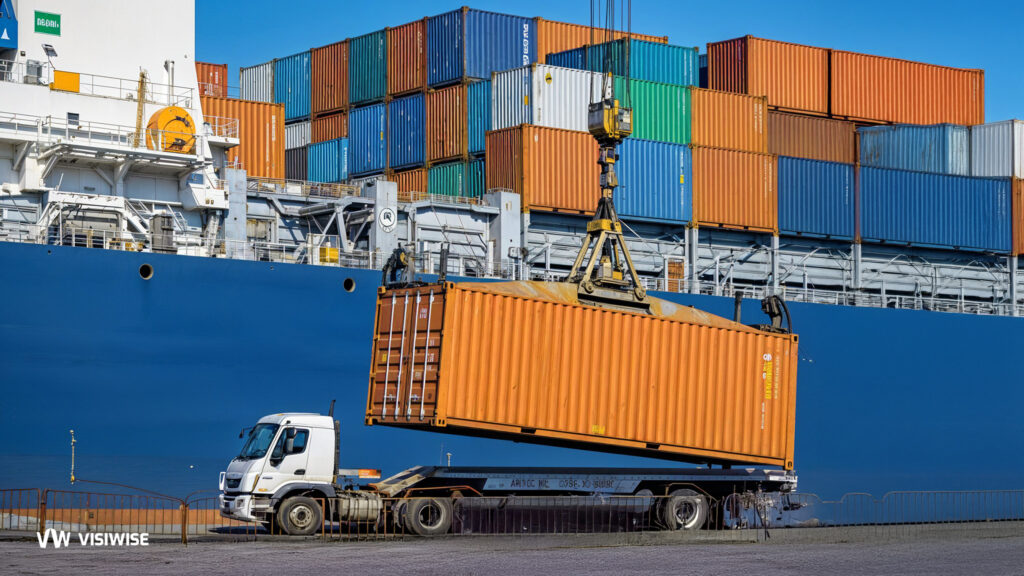Tracking shipments has always been an integral part of logistics, but let’s face it – the traditional method of tracking shipments is not always reliable. It can be problematic and may need significant human intervention to give accurate results. That’s where real-time shipment tracking comes in – an innovative technology that shrinks the gap between shipping carriers and customers. Real-time shipment tracking offers the ability to access pertinent information about the statuses of shipments at any given time along various phases of transit, from pick-up to final delivery. In this blog, we will delve deeper into the definition of real-time shipment tracking and the importance it plays in a fast-paced and ever-evolving shipping industry. We will showcase how real-time shipment tracking is transforming the logistics landscape and explore what the future holds for this exciting technology. Are you ready to join us on this journey? Let’s dive in!
The Traditional Method of Shipment Tracking
If you’ve ever shipped or received a package, you’re likely familiar with the traditional method of tracking shipments. This method usually involves a series of tracking numbers assigned to each package or parcel, which can be traced via website portals or customer service representatives. However, this method has its limitations, and many customers have expressed frustrations with the antiquated system.
One of the biggest drawbacks of the traditional method of shipment tracking is its reliability. Unfortunately, the traditional method doesn’t always give accurate, up-to-date information on the whereabouts of your package. This inaccuracy can be caused by a range of factors, from human error to technological constraints.
Another limitation of traditional shipment tracking is the lack of real-time information about the package. Often, tracking information is only updated once a package has been scanned at a particular destination, leading to delays in knowing the exact location of the package in transit. For instance, a package may leave a warehouse but not be registered as "shipped" until later in the day. This means that customers are often in the dark about the whereabouts of their package until it has already arrived.
Lastly, the traditional method of shipment tracking often requires excessive manual intervention, leading to more human errors and increased labor costs. From sorting and scanning to data entry and customer service, the traditional method consumes significant time and resources.
Despite these limitations, the traditional method of shipment tracking has been the norm for several years. However, the emergence of real-time shipment tracking technology promises to change this narrative. This technology aims to offer end-to-end visibility to improve the logistics industry. In the next section, we will discuss how real-time shipment tracking technology is revolutionizing the industry, and its importance in the modern shipping climate.
How Technology Is Advancing Real-time Shipment Tracking
The shortcomings of traditional shipment tracking have led to the emergence of a new era of logistics – one that emphasizes speed, accuracy, and real-time reporting. Technology plays a critical role in this transition, with various advancements driving the growth of the industry. Key technological enablers of real-time shipment tracking include sensor technology, GPS technology, and cloud-based tracking systems.
Sensor technology is a cornerstone of real-time shipment tracking. The technology involves attaching sensors to packages to obtain data at various stages of transit, from dispatch to delivery. This data is then sent to a central platform that provides real-time information on the package’s location, temperature, and condition. Sensor technology has been shown to enable enhanced supply chain visibility, which is essential to ensuring that cargo reaches its destination on time and in good condition.
Another crucial enabler of real-time shipment tracking is GPS technology. GPS technology allows shipping companies to track their vehicles and package delivery in real time. Because of this, customers can track their packages more accurately and know precisely when their delivery will arrive. Additionally, GPS technology can help shipping company optimize their routes for maximum efficiency, reducing overall transit times and costs.
Lastly, cloud-based tracking systems are transforming the logistics industry, making it more cost-effective and flexible. Cloud computing allows logistics providers to store vast amounts of data in a centralized system, improving visibility and making it easier to track shipments in real-time. With cloud computing, logistics providers can quickly adapt to changing supply chain demands, ensuring efficient operations and quick adaptations to increasing order volumes and other challenges.
Advantages of Real-time Shipment Tracking
Real-time shipment tracking is transforming the logistics industry, providing numerous benefits to logistics providers and customers alike. Below we’ll dive into some of the most significant advantages of real-time shipment tracking.
Improved supply chain visibility
Perhaps one of the most substantial benefits of real-time shipment tracking is the enhanced supply chain visibility that it offers. With real-time shipment tracking, logistics providers can track the location of their trucks, containers, and packages in real-time. This allows them to identify and rectify issues and inefficiencies in the supply chain miniaturized while helping them prepare for potential issues that may occur during transit. Additionally, real-time shipment tracking offers more detailed insights into how to optimize the supply chain to boost productivity and reduce costs.
Increased efficiency and productivity
Real-time shipment tracking also improves efficiency in the logistics industry. By providing real-time information about package locations, logistics providers can predict potential delays and react proactively. Thus it can avoid wasting time or delaying delivery. This technology helps logistics providers allocate resources more efficiently, making sure that they’re ready when customers need them. This heightened efficiency can also help reduce operational costs for logistics providers, leading to increased profits.
Enhanced customer experience
Real-time shipment tracking technology has the potential to improve customer experience by offering more accurate and timely delivery updates. Customers can track their packages in real-time and receive alerts as the packages move through the supply chain. This not only comes in handy for tracking the package in its transit but also for tracking its exact delivery time as well. Additionally, real-time tracking can help reduce product returns and manage customer expectations, leading to higher customer satisfaction and loyalty.
In conclusion, real-time shipment tracking technology offers significant benefits over the traditional shipment tracking method, including enhanced supply chain visibility, increased operational efficiency, and improved customer experience. By deploying real-time shipment tracking technology, logistics providers stand to gain a competitive edge in the ever-evolving logistics industry.
Implementation challenges and considerations
While real-time shipment tracking offers numerous advantages, the implementation process can be challenging for logistics providers. Companies need to consider various factors before deploying this technology. In this section, we will discuss some of the critical implementation challenges and considerations for logistics providers.
Cost considerations
One of the primary considerations for logistics providers is the cost of implementing real-time shipment tracking technology. This technology involves purchasing sensors and other tracking devices, adopting cloud computing, and integrating GPS technology within a trucking fleet. It can be expensive, and not every logistics provider may have the financial resources to implement it fully.
Security concerns
Another challenge is the security of the real-time shipment tracking system. As this technology involves the transfer of data, logistics providers need to ensure that their systems are using the latest and most robust security protocols. The sensitive information contained within the real-time tracking system, such as shipping addresses and payment data, must be protected at all times. Implementing adequate security measures can increase implementation costs and create operational challenges.
Technical challenges
Lastly, logistics providers need to consider if their logistics infrastructure and IT system’s capabilities are enough to support real-time shipment tracking. This technology requires a robust and reliable IT system that can handle the influx of real-time data they will generate. Companies may need to upgrade their infrastructure to support real-time shipment tracking or hire developers and IT staff to customize an existing platform or create a new one entirely.
While there are some implementation challenges of real-time shipment tracking, these can be overcome with careful planning and a systematic approach.
Real-world examples of companies using real-time shipment tracking
Real-time shipment tracking is not just an idea; it is a reality, and many logistics providers are already implementing it at scale. Let’s have a look at some of the examples of how real-time shipment tracking is being used in the industry.
Amazon Prime
Amazon Prime is known for its fast deliveries, and their secret to success is their use of real-time shipment tracking technology. The company deploys a highly sophisticated tracking system that allows customers to track packages as they move through the supply chain in real time. By using this technology, Amazon Prime can provide accurate delivery estimates and ensure on-time deliveries, which has helped them to improve customer loyalty.
DHL
DHL is one of the world’s largest logistics providers, and it uses real-time shipment tracking to enhance its global supply chain operations. It has deployed a comprehensive tracking system that allows customers to track packages on their website, mobile app, or via customer service representatives. By adopting real-time shipment tracking technology, DHL can provide an excellent customer experience, which translates to high customer satisfaction, enhanced brand reputation and quality of service.
FedEx
FedEx is another logistics provider that has been using real-time shipment tracking technology to improve its operations. Daily, they handle thousands of shipments, and real-time shipment tracking enables them to track every shipment in their global network in real-time. Their tracking system is renowned for its accuracy and speed, and it helps the company provide exceptional customer experiences and has led to the growth of its customer base.
The adoption of real-time shipment tracking technology by these companies has proved that it is possible to deploy this technology at scale, and it does have the potential to deliver significant improvements in logistics operations.
Future Trends and Possibilities
Real-time shipment tracking technology is continually evolving, with new innovations offering improved functionality and more accurate tracking. In this section, we will discuss the future trends and possibilities of this technology.
Artificial Intelligence (AI) for shipment tracking
Artificial intelligence is becoming more prevalent across the logistics industry, and its inclusion offers exciting possibilities for real-time shipment tracking. For instance, AI can help carriers predict delivery times more accurately, optimally reroute packages if necessary, and find alternative modes of transportation to mitigate delays. Essentially, AI-based shipment tracking offers more accuracy and visibility, leading to higher customer satisfaction and logistical efficiencies.
Blockchain for tracking shipments
Blockchain is a digital ledger technology that allows multiple parties to store and share data securely. In the context of logistics, blockchain offers the possibility of a more decentralized and automated tracking system that requires less oversight, streamlining the supply chain process. Since blockchain technology verifies transactions, it could potentially eliminate fraudulent practices like counterfeiting or cargo theft. This technology could also help logistics providers track goods in real-time and enhance supply chain visibility while reducing paperwork.
Internet of Things (IoT) integration in transportation
IoT is another technology that has vast potential for revolutionizing the logistics industry. IoT is a network of smart devices that are connected to the internet and communicate with each other. By integrating IoT into shipment tracking, logistics providers can collect and analyze data from a broad range of sources to obtain real-time data on the location, condition, and temperature of packages in transit. They can then analyze this data to optimize the supply chain process, reduce transit times, and improve customer satisfaction.
Real-time shipment tracking technology is continually maturing and becoming more refined. These advances will offer greater efficiencies, better control, and improved visibility across the supply chain. It provides limitless possibilities for the logistics industry and the potential to enhance service delivery while reducing operational costs.
Visiwise Visibility Platform: A Reliable Real-Time Shipment Tracking
Looking for a reliable and efficient real-time shipment tracking software that can provide you with end-to-end visibility across your supply chain? Look no further than the Visiwise Visibility platform!
Visiwise is a cloud-based shipment tracking software that enables logistics providers to track shipments in real-time, providing customers with accurate and timely delivery updates. With Visiwise, businesses can optimize their supply chain, reduce costs and provide an exceptional customer experience.
Visiwise is built on advanced sensor technology, GPS tracking, and cloud-based tracking systems, which enable logistics providers to monitor their inventory and movements in real-time. This technology ensures that logistics providers can track their packages accurately, identify and resolve inefficiencies as they arise, optimize their resources, and reduce transit times, costs, and overall operational expenses.
Furthermore, Visiwise’s advanced AI-powered algorithms allow logistics providers to anticipate potential delivery delays and communicate proactively with their customers, providing end-to-end shipment visibility throughout the entire transport process. The software also offers email and SMS notifications, enabling customers to stay informed of delivery status in real-time.


